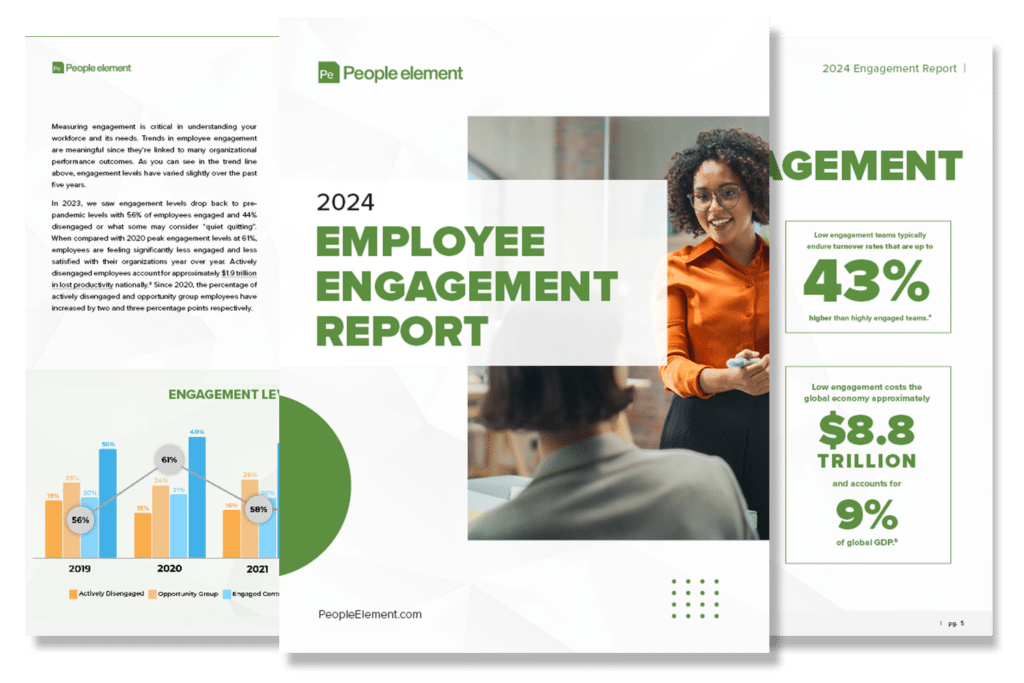When the budget is tight, it seems like HR and employee-related initiatives are the first on the chopping block. What organizations don’t realize is that the ROI of HR is huge and can drive profits. In a recent webinar, we walked through how HR can save their company thousands of dollars by using employee feedback to reduce turnover. Our hosts showed how there can be ROI at each step of the employee journey and how you can start collecting feedback with employee surveys.
Key Takeaways:
- Employee engagement isn’t just nice to know, it drives real business outcomes.
- If you know the outcomes, can quantify Turnover, and understand what the data means for your business then the ROI of HR is real.
- Being able to talk about these items helps the business invest in HR.
- There are science-backed approaches and question sets to drive strong data.
- We care deeply about helping HR leaders make work better for employees and want to support you however we can.
Cost of Turnover
Do you know the cost of turnover in your organization? We asked this question during the live webinar and 80% of respondents answered no. Turnover costs are unique to each company and can vary widely from year to year. A Gallup study found that replacing an employee can add up to two times their annual salary, costing between $25,000 and $100,000. If we think about all of the cost that goes into searching for, interviewing, vetting, onboarding, and training an employee — those add up quickly. Cutting employee turnover, even just a few percentage points, can have a sizable impact on profit.
Engagement’s Impact on Profits
Many people perceive employee engagement as a “fluff” concept, or that it is nice to have but it doesn’t really have an impact. Well, in the wise words of Dwight Schrute, “False.” Having high engagement in your company actually has a significant effect on many business outcomes. Studies show that high-engagement workplaces earn 8% more revenue per employee and 21% higher levels of profitability. Along with this, it improves productivity, sales, and well-being while decreasing turnover, accidents, and absenteeism.

Source: Gallup
ROI of HR Feedback
Engagement isn’t the only thing that can have a positive impact on decreasing turnover and boosting profits. There are ROI possibilities across the whole employee journey through feedback, from onboarding to exits and everything in between. Here are a few key places to focus on:
- Onboarding: Make a good first impression with a strong onboarding process that brings your new hire up to speed quickly and makes them feel comfortable. A strong onboarding process improves new hire retention by 82% and productivity by 70%. Checking in on employees early and asking them how their onboarding is going in a quick survey makes them feel appreciated from the start.
- Well-being: Workplace stress adversely affects productivity and costs US employers nearly $300 billion every year. Asking people how the company could support their well-being at work and implementing initiatives around it could help employees and save money in the process.
- Exit Interviews: Understanding why employees decide to leave can be a roadmap that leads to less turnover. You can use exit interviews as a tool and use that feedback to make changes that will hopefully stop others from leaving for the same reasons. Ending on good terms with employees is also beneficial because they may be interested in returning to the company in the future. Rehiring a past employee can be a lot easier than starting fresh with a new hire because they already have fundamental training and know the environment. Research found that 1 in 5 people who quit their jobs since the pandemic have returned to their previous employers.
Getting Actionable Data
Now that we’ve laid out the benefits and ROI of feedback, we’re going to share some best practices that will help you get actionable data. Using surveys for employee feedback probably seems like a no-brainer (it is) but we want to make sure you are setting yourself up for success and an accurate measurement. Here’s a few things to consider:
- Design survey questions with the outcome in mind. If you want to learn what is affecting engagement, you need to ask the right questions that can lead you to an answer.
- Use validated surveys backed by science. Not all surveys or survey companies are made the same. Make sure you are using one that was created intentionally and developed with organizational psychology in mind. (Like ours!)
- Create benchmarks of key metrics that can be measured on a regular basis. You’ll never know if you are moving the needle on anything if you aren’t consistent in your measurements.
These are just a few things that you can do, and we cover them in much more detail in the full webinar recording.
If you are interested in taking the next step with your employee engagement, explore our all-inclusive employee survey platform that can help you measure and gain insights from your people. We make collecting feedback easy and help you put your insights into action quickly for great results. Contact us TODAY!
Download Full Webinar
Download the webinar below for the full presentation and dig deeper with our ROI Guidebook.





